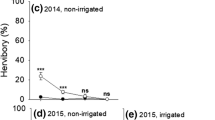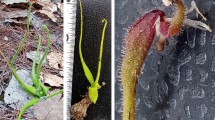Abstract
This experiment investigates how pulsed nutrient resources interact with intraspecific competition to influence biomass production and nutrient use efficiency in the American bellflower (Campanulastrum americanum). The competitive environment of these plants was manipulated by growing plants alone or with neighboring conspecifics, and the occurrence of pulsed nutrient resources was manipulated through the addition of 17-year periodical cicada (Magicicada septendecim) carcasses in order to simulate naturally occurring pulsed resources in this system. The addition of cicada carcasses increased mean plant biomass by 61 % compared to non-supplemented plants, while competition decreased mean plant biomass by 44 % compared to plants grown without competition; these effects were additive. In comparison, nutrient use efficiency decreased in fertilized plants (cicada-supplemented plants showed 20 % greater foliage nitrogen concentrations compared to non-supplemented plants), but was not significantly affected by the plant’s competitive environment. In addition, cicada supplementation did not significantly increase the biomass asymmetry in competing pairs of plants. These results suggest that these plants increased their total nutrient uptake at a timescale commensurate with the pulsed increase in nutrient availability due to cicada carcass decomposition.

Similar content being viewed by others
References
Baskin JM, Baskin CC (1984) The ecological life-cycle of Campanula americana in north central Kentucky. Bull Torrey Bot Club 111:329–337
Berendse F, Aerts R (1987) Nitrogen-use-efficiency: a biologically meaningful definition? Funct Ecol 1:293–296
Birk EM, Vitousek PM (1986) Nitrogen availability and nitrogen use efficiency in loblolly pine stands. Ecology 67:69–79
Boutin S, Wauters LA, McAdam AG et al (2006) Anticipatory reproduction and population growth in seed predators. Science 314:1928–1930
Chapin FS (1980) The mineral nutrition of wild plants. Annu Rev Ecol Syst 11:233–260
Chen B, Wise DH (1999) Bottom-up limitation of predaceous arthropods in a detritus-based terrestrial food web. Ecology 80:761–772
Dybas HS, Davis DD (1962) A population census of seventeen-year periodical cicadas (Homoptera: Cicadidae: Magicicada). Ecology 43:432–444
Galloway LF (2001a) The effect of maternal and paternal environments on seed characters in the herbaceous plant Campanula americana (Campanulaceae). Am J Bot 88:832–840
Galloway LF (2001b) Parental environmental effects on life history in the herbaceous plant Campanula americana. Ecology 82:2781–2789
Galloway LF, Etterson JR (2009) Plasticity to canopy shade in a monocarpic herb: within- and between-generation effects. New Phytol 182:1003–1012. doi:10.1111/j.1469-8137.2009.02803.x
Gebauer R, Schwinning S, Ehleringer J (2002) Interspecific competition and resource pulse utilization in a cold desert community. Ecology 83:2602–2616
Gratton C, Denno RF (2003) Inter-year carryover effects of a nutrient pulse on Spartina plants, herbivores, and natural enemies. Ecology 84:2692–2707
Harpole WS, Tilman D (2007) Grassland species loss resulting from reduced niche dimension. Nature 446:791–793
Hodge A (2004) The plastic plant: root responses to heterogeneous supplies of nutrients. New Phytol 162:9–24
Hoekman D, Dreyer J, Jackson RD et al (2011) Lake to land subsidies: experimental addition of aquatic insects increases terrestrial arthropod densities. Ecology 92:2063–2072. doi:10.1890/11-0160.1
Holt RD (2008) Theoretical perspectives on resource pulses. Ecology 89:671–681
Jankju-Borzelabad M, Griffiths H (2006) Competition for pulsed resources: an experimental study of establishment and coexistence for an arid-land grass. Oecologia 148:555–563. doi:10.1007/s00442-006-0408-1
Karban R (1984) Opposite density effects of nymphal and adult mortality for periodical cicadas. Ecology 65:1656–1661
Koenig WD, Liebhold AM (2003) Regional impacts of periodical cicadas on oak radial increment. Can J for Res 33:1084–1089
Miao SL, Bazzaz FA (1990) Responses to nutrient pulses of two colonizers requiring different disturbance frequencies. Ecology 71:2166–2178
Nowlin WH, González MJ, Vanni MJ et al (2007) Allochthonous subsidy of periodical cicadas affects the dynamics and stability of pond communities. Ecology 88:2174–2186
Ostfeld RS, Keesing F (2000) Pulsed resources and community dynamics of consumers in terrestrial ecosystems. Trends Ecol Evol 15:232–237
Peek MS, Forseth IN (2003) Microhabitat dependent responses to resource pulses in the arid land perennial, Cryptantha flava. J Ecol 91:457–466
R Development Core Team (2011) R: a language and environment for statistical computing. Austria, Vienna
Shaver GR, Melillo JM (1984) Nutrient budgets of marsh plants—efficiency concepts and relation to availability. Ecology 65:1491–1510
Weiner J (1986) How competition for light and nutrients affects size variability in Ipomoea tricolor populations. Ecology 67:1425–1427
Weiner J (1990) Asymmetric competition in plant-populations. Trends Ecol Evol 5:360–364
Weiner J, Solbrig OT (1984) The meaning and measurement of size hierarchies in plant populations. Oecologia 61:334–336
Whiles MR, Callaham MA, Meyer CK et al (2001) Emergence of periodical cicadas (Magicicada cassini) from a Kansas riparian forest: densities, biomass and nitrogen flux. Am Midl Nat 145:176–187
Williams KS, Simon C (1995) The ecology, behavior, and evolution of periodical cicadas. Annu Rev Entomol 40:269–295
Williams KS, Smith KG, Stephen FM (1993) Emergence of 13-year periodical cicadas (Cicadidae, Magicicada)—phenology, mortality, and predator satiation. Ecology 74:1143–1152
Wilson SD, Tilman D (1993) Plant competition and resource availability in response to disturbance and fertilization. Ecology 74:599–611
Yang LH (2004) Periodical cicadas as resource pulses in North American forests. Science 306:1565–1567
Yang LH (2006) Interactions between a detrital resource pulse and a detritivore community. Oecologia 147:522–532
Yang LH (2008) Pulses of dead periodical cicadas increase herbivory of American bellflowers. Ecology 89:1497–1502
Yang LH, Karban R (2009) Long-term habitat selection and chronic root herbivory: explaining the relationship between periodical cicada density and tree growth. Am Nat 173:105–112
Yang LH, Bastow JL, Spence KO, Wright AN (2008) What can we learn from resource pulses? Ecology 89:621–634
Yang LH, Edwards K, Byrnes JE et al (2010) A meta-analysis of resource pulse–consumer interactions. Ecol Monogr 80:125–151
Acknowledgments
I thank the Mountain Lake Biological Station and Blandy Experimental Farm at the University of Virginia for field site assistance. Thanks to David Carr, T’ai Roulston, and Rick Karban for assistance in the field, and Rick Karban, Tom Schoener, Kevin Rice, Jonathan Levine and Tabatha Bruce for helpful comments on earlier versions of this manuscript. This research was supported by the Center for Population Biology and Section of Evolution and Ecology at the University of California, Davis and the National Science Foundation Graduate Research Fellowship Program.
Author information
Authors and Affiliations
Corresponding author
Additional information
Handling Editor: Gary Felton.
Rights and permissions
About this article
Cite this article
Yang, L.H. Resource pulses of dead periodical cicadas increase the growth of American bellflower rosettes under competitive and non-competitive conditions. Arthropod-Plant Interactions 7, 93–98 (2013). https://doi.org/10.1007/s11829-012-9223-2
Received:
Accepted:
Published:
Issue Date:
DOI: https://doi.org/10.1007/s11829-012-9223-2




